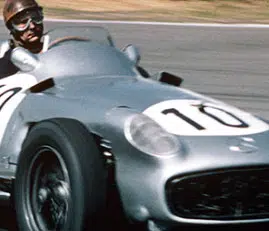After the first practice period, it was clear that all records for the race would be broken, and that the difference between the Alfa-Romeo team and the Ferrari team was not very great. This meant that pit stops would play a vital part in the outcome of the race and this they did to a greater extent than anyone anticipated.
The starting list of thirteen cars made up in quality what it lacked in quantity, with three 159 Alfa-Romeos, three 4 1/2-litre 24-plug Ferraris and seven Talbot-Lagos. Fangio had the latest 159 Alfa with de. Dion rear axle, fuel tanks on either side of the driver's legs, another in the top of the scuttle and a long cylindrical one alongside the engine on the off-side, all in addition to the normal fuel tank, giving a capacity of some 70 gallons. Farina and Sanesi had the normal swing-axle 159 cars, the former with a similar tank layout to Fangio's, less the scuttle top tank and the latter with three cockpit tanks. In practice it had beem found that tyre wear was excessive, due to the non-skid surface, and Fangio was using 700 by 19 Englebert tyres on the rear against his team mates' 18-in. tyres. The 19-in, wheels were a new type with alloy rims and all the spokes on the inside; in other words the rim was offset to the hub. Ferraris increased their rear tyres to 750 by 17 with 600 by 16 on the front. Ascari, Villoresi and Taruffi all had 24-plug engines with three 46mm. Weber carburetters and the now standard de Dion axle long chassis. The first two were complete new cars and Taruffi's was the chassis driven by Ascari at Berne. Of the Talbots there was little new, apart from Rosier having a modified air intake and Claes having three S.U. carburetters in place of the original Zeniths. Giraud-Cabantous was driving his ex-Sommer car and the young Belgian Andre Pilette was driving his newly acquired ex-Grignard car. Other Talbots were driven by Chiron, Levegh and Etancelin.
As is becoming general practice now, Alfa-Romeos did not dominate the starting grid, for Villoresi was in the front row with Fangio and Farina, while second row was occupied by Ascari and Taruffi, Sanesi in the third Alfa being behind with the Talbots. The start was notable for Farina putting his goggles on at the five seconds to go signal, Ascari jumping the start and Sanesi stalling and being left behind. The field almost immediately divided into groups, the first containing the Italians, the second the Talbots of Rosier and Cabantous, with the rest of the field in the third group. After three laps Farina drew away slowly but surely from the rest of his group, reducing his lap time to 4 min. 27 sec. On laps 9 and 10 Fangio opened up and clocked 4 min. 29.9 sec., and 4 min. 22.1 sec., the last being the ultimate lap record, equal to a speed of 120.44. m.p.h. This brought him very close to Farina who was about due for his first pit stop, but at the end of lap 12 when everyone was ready in the pit Farina went straight by and didn't come in until the and of the 14th lap. In under one minute he had been refuelled and new rear wheels and was away with Fangio now in the lead. One more lap and the Argentine came in for the same treatment, but then pandemonium broke out for the near-side rear wheel would not come off the hub. A spoke head had got behind the splines and no amount of levering or banging would move it. Six and a half minutes had ticked by before the complete wheel, hub and brake drum were removed from the half-shaft and still the hub could not be levered out. Meanwhile everyone had gone by and all hopes of regaining the lead were gone for Fangio.





